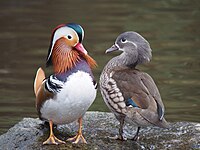
Photo from wikipedia
Abstract Observational studies have suggested that the presence of snail shells correlates with the presence of specialized adopters, particularly bees and wasps (Hymenoptera: Aculeata). However, should the empty shells be… Click to show full abstract
Abstract Observational studies have suggested that the presence of snail shells correlates with the presence of specialized adopters, particularly bees and wasps (Hymenoptera: Aculeata). However, should the empty shells be considered limiting resources once they are present in the respective habitat even if observational studies suggested low ratio of occupied relative to total shells? We performed a manipulative experiment, which consisted of the addition of marked snail shells of six terrestrial species that dominate the open and semi-open central European habitats to 21 sites with naturally present shells. We deployed empty shells for the spring and summer 2017, allowed their inhabitants to undergo a diapause during the follow-up winter period and complete metamorphosis. The specialized bee and wasp species abundantly occupied the provided shells and the occupancy rates were several times higher in experimentally provided shells compared to the naturally present shells. These differences in occupancy rates were higher at anthropogenic compared to natural sites and at sites with more limited availability of naturally present shells. In contrast, the few sites at which the examined resource was superabundant, both the naturally present and the experimentally provided shells were occupied only to a limited extent. The species composition of assemblages that occupied the experimentally provided and naturally present shells were similar, and the differences in species composition between the natural and anthropogenic sites resembled those exhibited in the naturally present shells. In conclusion, we experimentally confirmed that empty snail shells serve as limiting resources for specialized bees and wasps even at sites where the naturally present shells are perceived as abundant.
Journal Title: Ecological Engineering
Year Published: 2020
Link to full text (if available)
Share on Social Media: Sign Up to like & get
recommendations!